It's a bear market
By Colin Twiggs
March 3, 2016 7:00 p.m. AEDT (3:00 a.m. EST)
Advice herein is provided for the general information of readers and does not have regard to any particular person's investment objectives, financial situation or needs. Accordingly, no reader should act on the basis of any information contained herein without first having consulted a suitably qualified financial advisor.
Before discussing the latest rally, I would like to remind readers:
- This is a bear market.
- The latest rally does not constitute a reversal.
It is easy to lose track of this when focusing on daily charts.
Iron ore surged in recent weeks, following the announcement of further stimulus measures by China, including a reduction in reserve requirements to stimulate bank lending. From Reuters:
The [Dalian Commodity Exchange] spot benchmark hit $50.50 last week, its highest since October. For the year, iron ore has risen 17.5 percent, outpacing gold to be among this year's top performing commodities. China's plans to reduce overcapacity in sectors including steel also bode well for the sector, traders said, and could support prices more sustainably going forward. China said on Monday it expected to lay off 1.8 million workers in the coal and steel industries, or about 15 percent of the workforce, as part of efforts to reduce industrial overcapacity, and will allocate 100 billion yuan over two years to relocate laid off workers.
It seems inconsistent that an announced lay-off of 1.8 million workers would cause a rally in the resources sector. Reduced steel-making capacity is unlikely to lead to increased demand for iron ore.
Global
Dow Jones Global Index is headed for a test of resistance at 300. 13-Week Twiggs Momentum continues to flag a strong primary down-trend. Respect of 300 is likely and reversal below 290 warn of another decline. Breach of 270 would confirm. Penetration of the descending trendline is unlikely but would warn that the down-trend is losing momentum and a bottom is forming.
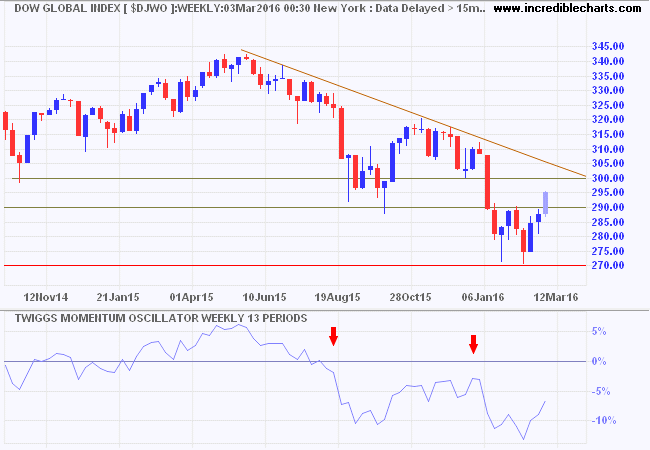
* Target calculation: 270 - ( 300 - 270 ) = 240
North America
Breakdown of quarterly earnings per share (EPS) by S&P 500 sector, up to Quarter 4 2015, displays resilient performance by all sectors except Energy. Impact of the Energy contraction on other sectors such as Finance, however, may take several quarters to filter through.
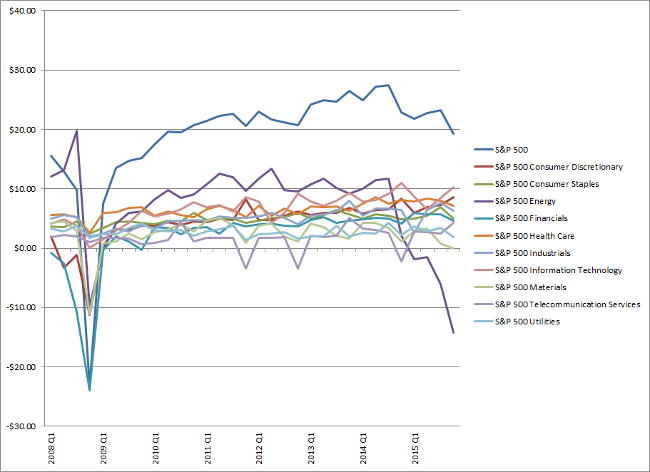
The S&P 500 is testing resistance at 2000. Penetration seems likely and would signal a test of 2100. That is the real acid-test. Strong resistance at 2100 and a lower peak would confirm the bear market. Breakout is unlikely, but would indicate that selling pressure has eased. Rising 13-week Twiggs Money Flow indicates medium-term buying pressure.
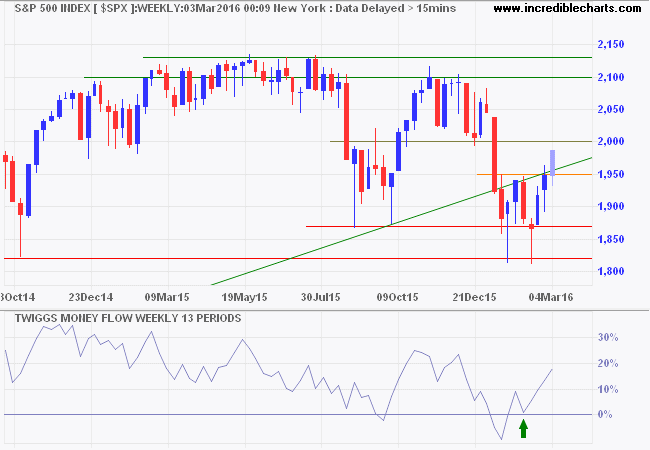
* Target calculation: 1900 - ( 2100 - 1900 ) = 1700
CBOE Volatility Index (VIX) broke 'support' at 20, suggesting that (short-term) market risk is easing.
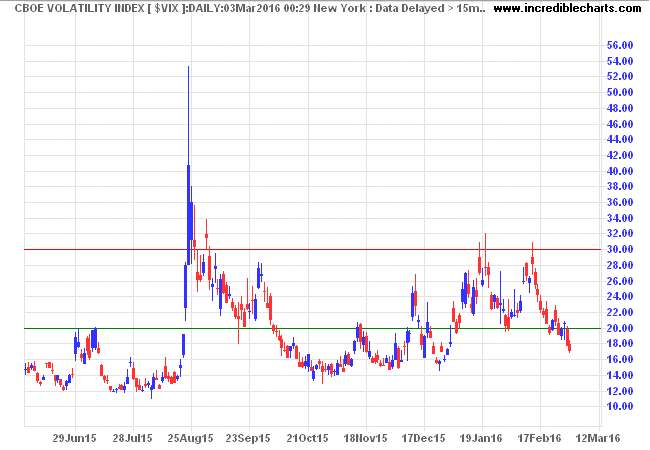
Canada's TSX 60 is testing the descending trendline after breaking resistance at 750. Penetration would suggest that the down-trend is losing momentum and a bottom is forming. Rising 13-week Twiggs Momentum is so far indicative of a secondary rally rather than reversal of the primary down-trend.
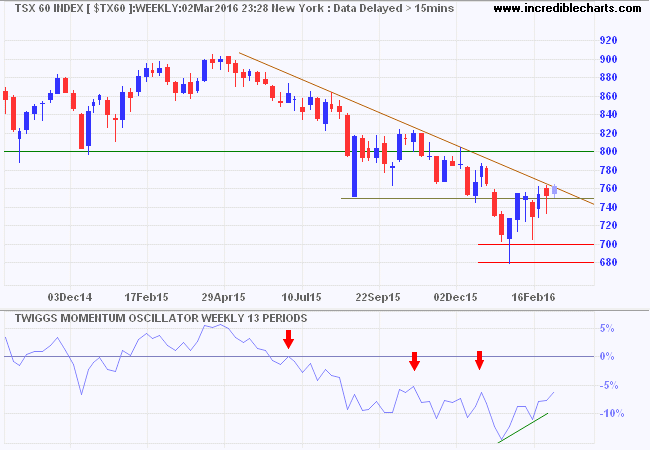
* Target calculation: 700 - ( 750 - 700 ) = 650
Europe
Dow Jones Euro Stoxx 50 broke resistance at 3000, indicating a test of 3300. Retracement that respects the new support level would strengthen the signal. A higher trough on 13-week Twiggs Money Flow appears secondary, indicating medium-term buying pressure. But the primary trend remains down. A lower peak, followed by reversal below 3000, would signal decline to 2400*.
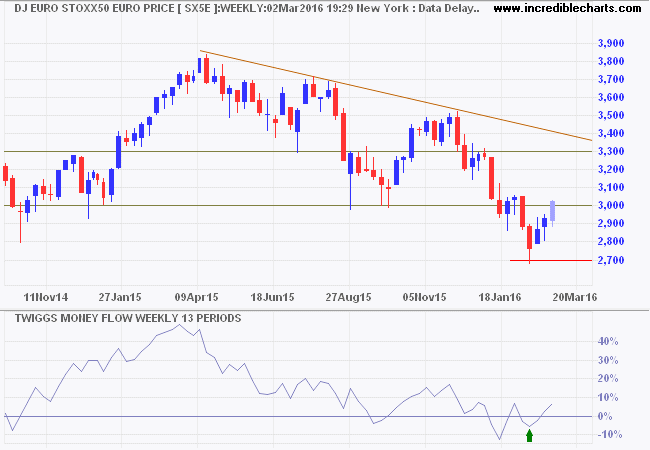
* Target calculation: 2700 - ( 3000 - 2700 ) = 2400
Germany's DAX is testing resistance at 10000. Breakout would indicate an advance to 11000. Buying pressure on 13-week Twiggs Money Flow again appears secondary and reversal below 9300 would signal another decline.
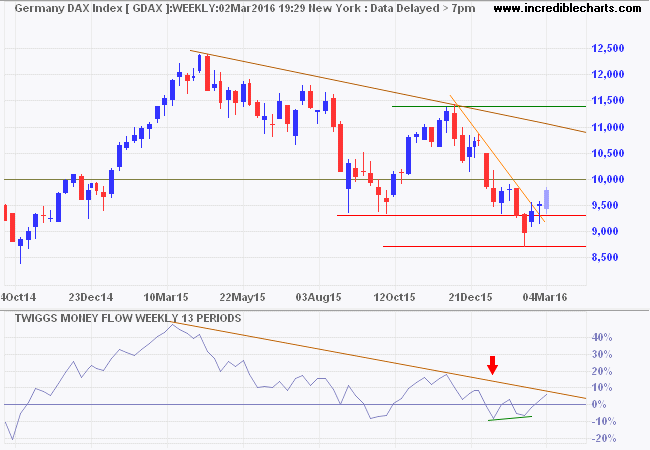
* Target calculation: 9500 - ( 11500 - 9500 ) = 7500
The Footsie recovered above 6000 and the descending trendline, suggesting that a bottom is forming. Buying pressure on 13-week Twiggs Money Flow again appears secondary and reversal below 6000 would signal another test of primary support at 5500.
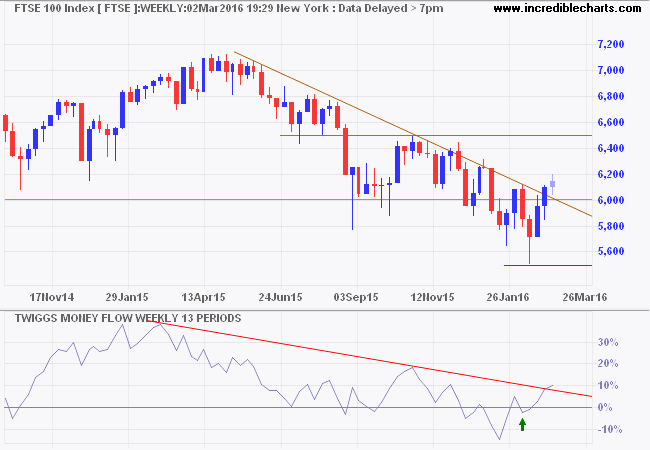
* Target calculation: 6000 - ( 6500 - 6000 ) = 5500
Asia
The Shanghai Composite Index again found support at 2700, suggesting another test of resistance at 3000. The primary trend is down and likely to remain so.
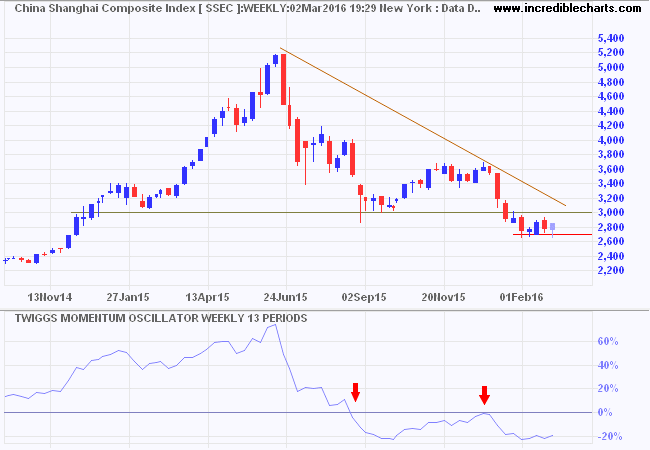
* Target calculation: 3000 - ( 3600 - 3000 ) = 2400
Japan's Nikkei 225 Index is testing resistance at 17000. Respect of 18000 would warn of another test of 15000. Decline of 13-week Twiggs Money Flow below zero would strengthen the signal.
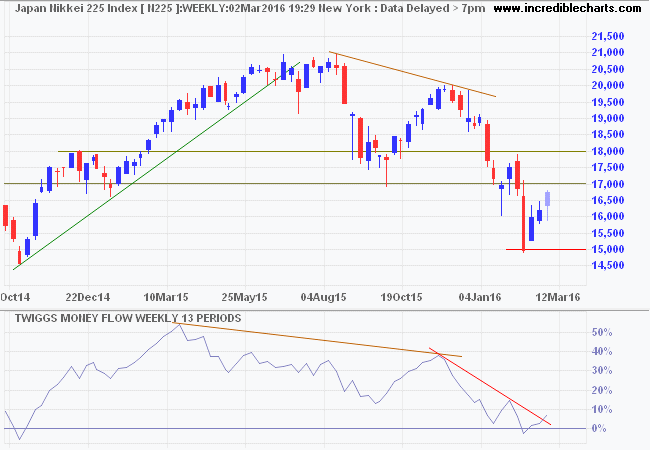
* Target calculation: 17000 - ( 20000 - 17000 ) = 14000
India's Sensex displays healthy buying pressure on 13-week Twiggs Money Flow. The primary trend remains down, but expect a test of the upper trend channel at 26000. Reversal below 23000 is unlikely in the short-term, but would offer a target of 22000*.
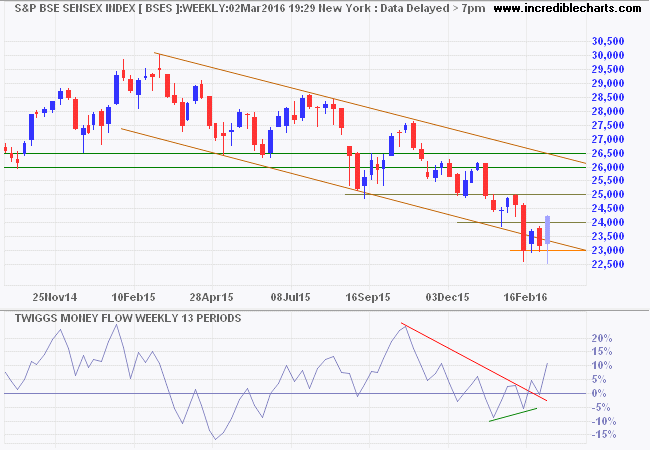
* Target calculation: 23000 - ( 24000 - 23000 ) = 22000
Australia
The ASX 200 broke resistance at 5000 and is likely to test 5150. Respect of the descending trendline would warn of another decline. Penetration would suggest that a bottom is forming despite strong headwinds faced by the Australian economy:
- Collapse of mining investment;
- Shuttering of motor manufacturing; and
- A sputtering housing recovery despite low interest rates.
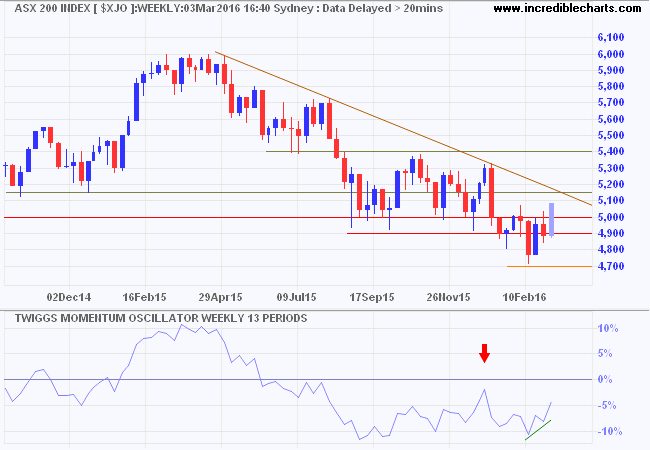
* Target calculation: 4700 - ( 5000 - 4700 ) = 4400; 5000 - ( 6000 - 5000 ) = 4000
Banks rallied strongly, but the primary trend remains down. Declining 13-week Twiggs Money Flow, below zero, reflects long-term selling pressure.
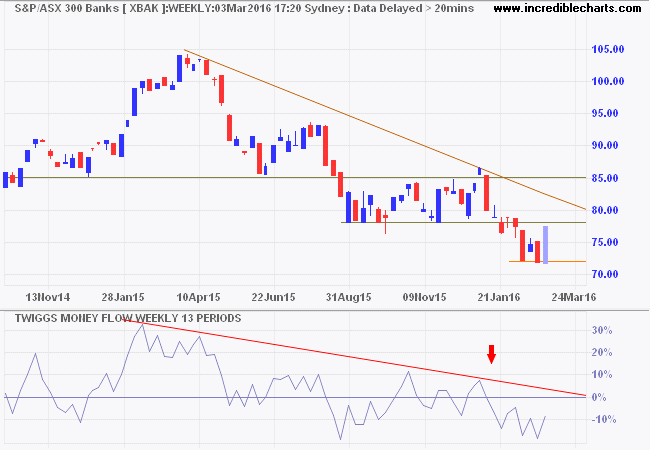
My losses have taught me that I must not begin to advance until I am sure I shall not have to retreat.
~ Jesse Livermore
Disclaimer
Porter Private Clients Pty Ltd, trading as Research & Investment ("R&I"), is a Corporate Authorized Representative (AR Number 384 397) of Andika Pty Ltd which holds an Australian Financial Services Licence (AFSL 297069).
The information on this web site and in the newsletters is general in nature and does not consider your personal circumstances. Please contact your professional financial adviser for advice tailored to your needs.
R&I has made every effort to ensure the reliability of the views and recommendations expressed in the reports published on its websites and newsletters. Our research is based upon information known to us or which was obtained from sources which we believe to be reliable and accurate.
No guarantee as to the capital value of investments, nor future returns are made by R&I. Neither R&I nor its employees make any representation, warranty or guarantee that the information provided is complete, accurate, current or reliable.
You are under no obligation to use these services and should always compare financial services/products to find one which best meets your personal objectives, financial situation or needs.
To the extent permitted by law, R&I and its employees, agents and authorised representatives exclude all liability for any loss or damage (including indirect, special or consequential loss or damage) arising from the use of, or reliance on, any information. If the law prohibits the exclusion of such liability, such liability shall be limited, to the extent permitted by law, to the resupply of the said information or the cost of the said resupply.
Important Warning About Simulated Results
Research & Investment (R&I) specialise in developing, testing and researching investment strategies and systems. Within the R&I web site and newsletters, you will find information about investment strategies and their performance. It is important that you understand that results from R&I research are simulated and not actual results.
No representation is made that any investor will or is likely to achieve profits or losses similar to those shown.
Simulated performance results are generally prepared with the benefit of hindsight and do not involve financial risk. No modeling can completely account for the impact of financial risk in actual investment. Account size, brokerage and slippage may also diverge from simulated results. Numerous other factors related to the markets in general or to the implementation of any specific investment system cannot be fully accounted for in the preparation of simulated performance results and may adversely affect actual investment results.
To the extent permitted by law, R&I and its employees, agents and authorised representatives exclude all liability for any loss or damage (including indirect, special or consequential loss or damage) arising from the use of, or reliance on, any information offered by R&I whether or not caused by any negligent act or omission.

Author: Colin Twiggs is a former investment banker with almost 40 years of experience in financial markets. He co-founded Incredible Charts and writes the popular Trading Diary and Patient Investor newsletters.
Using a top-down approach, Colin identifies key macro trends in the global economy before evaluating selected opportunities using a combination of fundamental and technical analysis.
Focusing on interest rates and financial market liquidity as primary drivers of the economic cycle, he warned of the 2008/2009 and 2020 bear markets well ahead of actual events.
He founded PVT Capital (AFSL No. 546090) in May 2023, which offers investment strategy and advice to wholesale clients.
